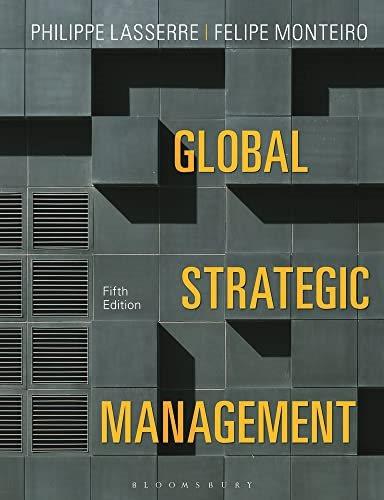Founded in 1995 by Mr Wang Chuanfu in Shenzhen, Southern China, BYD (Build Your Dreams) is today
Question:
Founded in 1995 by Mr Wang Chuanfu in Shenzhen, Southern China, BYD (Build Your Dreams) is today the largest supplier of rechargeable batteries in the world and has diversified into electronic components, car manufacturing and solar energy. It has operations primarily in China, India, Hungary and Brazil and employs more than 180,000 people. Its turnover in 2010 was 46 billion Yuan RMB ($6.8 billion).
Mr Wang was a chemist and researcher at Beijing Non-Ferrous Metal Research Institute who was assigned to be the general manager of a government-owned battery factory. After reading that Japan was going to stop the production of the NiCd1 battery because of environment concerns, Wang quit his job and founded Shenzhen BYD Battery Company Limited with 2.5 million Yuan RMB borrowed from his cousin. The company started with 20 employees.
When BYD started out, making rechargeable batteries for tools like electric drills, Wang and his engineers built their own production line on which the cheap cost of labour replaced expensive machinery, giving BYD a competitive advantage on price. In 2000, it qualified as a Li-ion battery supplier for Motorola and, in 2002, for Nokia. BYD had to compete not only with traditional Japanese battery makers but more and more with local newcomers who tried to copy BYD’s production system.
With increased competition, Wang diversified into making components such as LCD screens, keypads and modules for mobile phone manufacturers. Those electronic manufacturing activities became the second pillar of the BYD corporate portfolio. In 2008, this division bought Sino MOS, which specialized in semiconductor technology and became a significant part of BYD activities.
However, the major strategic move came on 22 January 2003 when BYD purchased Xi’an Tsinchuan Auto Co. and entered the auto industry. Immediately Wang replicated in the car industry his method of production based on cheap labour-intensive methods rather than expensive automation. But BYD also had to build an R&D capability, so Wang went to top universities and hired thousands of new mechanics and engineering graduates. By the end of 2009, BYD had more than 12,000 engineers working in basic R&D functions. Wang remarked that he was blessed with engineers who worked hard for only 3,600 Yuan RMB a month. He also engaged in reverse engineering practices, dismantling competitors’ products in order to understand and possibly replicate some components. Another practice derived from the battery business was the vertical integration and manufacture of most of the parts internally. Wang bought a mould-making factory in Beijing and another in Japan.
The first car produced by the company, the BYD F3, was very much like the Toyota Aygo. In order to fight a possible law suit, BYD hired 200 legal staff.
In 2007, Warren Buffett’s Berkshire Hathaway bought 10 per cent of BYD shares for $230 million.
In 2008, Wang announced the launch of a hybrid model and a fully electric car for 2009.
By 2009 the F3 was a success with 290,000 cars sold, and Wang announced his intention to become the number 1 car maker in China by 2015 and the world’s best car maker in 2025.
In the electric car business, Wang claimed a competitive advantage in electric car battery with BYD’s lithium-ion ferrous phosphate (LFP)
technology.
The launch of the first purely electric vehicle was announced in January 2010.
However, 2010 was marked by a decline in profits due to distribution problems.
In 2011, BYD and Daimler signed a memorandum of understanding and announced they would jointly launch electric cars under a new brand in China in 2013 through Shenzhen BYD Daimler New Technology Co. Ltd. This joint venture had a capital of 600 million Yuan RMB, combining Daimler’s proprietary technologies in vehicle structure and safety with BYD’s auto battery.
On the battery side of the business, in 2008, BYD signed an agreement with the local government of Shangluo, Shannxi, to build a solar-powered battery plant and announced that it would build 5,000 MW per year of solar photovoltaic cell manufacturing capacity at a cost of 22.5 billion Yuan RMB by 2015. This was considerably more than Suntech Power Holdings Co. Ltd, a major Chinese player in this market, whose capacity was about 100 MW per year.
In October 2011, BYD opened its North American headquarters in Los Angeles.
In 2014, it opened the first iron phosphate battery production plant in Manaus (Brazil) and expanded to the production of lithium phosphate in 2020.
In 2015, it began producing a new electric bus model, in Brasilia, in cooperation with the local bus body maker Marcopolo.
The BYD revenues grew from from $12 billion in 2015 to $18 billion in 2019.
Its revenues come from the following sources:
China (84 per cent), Asia Pacific (8 per cent), USA and rest of the world (8 per cent).
Questions:
1 How do you account for the success of BYD?
2 Given what you know of the global car industry, do you think that BYD is on course to realize Wang’s dream of becoming the number 1 global player? What elements are in its favour?
What elements may prevent this goal from being achieved?
Step by Step Answer:

Global Strategic Management
ISBN: 9781350932968
5th Edition
Authors: Philippe Lasserre, Felipe Monteiro





